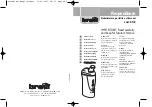
9
PA30 Series Powered Air-Purifying Respirator
PA3/PA3IS Blower Assembly User Manual
Tr
oubleshooting/Cleaning and Stor
age
Troubleshooting
The following guide will enable you to locate and correct malfunctions:
Possible Cause
Solution
Low Voltage
Re-charge battery.
Air inlet to hood is twisted or constricted,
Remove, inspect, and reinsert PA1BT
or breathing tube inserted incorrectly
Breathing Tube approximately 5" into
hood inlet.
Clogged/damaged air-purifying
Replace the filter cartridge.
filter element
Battery low
Re-charge battery.
Blower malfunction
Replace blower.
Breathing tube or hood damaged
Replace breathing tube and/or hood.
Equipment damaged or filter
Leave hazardous area immediately
needs to be replaced
and check equipment.
Replace filter.
If the problem persists and no
damage is found, return equipment
for repair.
Low airflow
See above.
Improper initial charge
Review “Initial Charging Procedure”
Prolonged storage of unit not on charger
on page 4.
Cleaning
Avoid contaminant entry into the breathing tube, as this will
compromise respiratory protection and could result in death or
serious injury. Consult your local safety professional if you
suspect that contaminant has entered the breathing tube. When
cleaning the equipment, do the following:
Ensure water does not enter cartridges. Replace wet cartridges.
DO NOT
use gasoline, organic-based solvents, or chlorinated
degreasing fluids (such as trichloroethylene) as they will cause
damage.
DO NOT
immerse the equipment in water or other cleaning fluid
as this may cause contamination in the breathing tube and
blower interior that will be difficult to remove.
Failure to observe the instructions and warnings in this manual
invalidates all performance statements and approvals for this
equipment and could result in death or serious injury.
Once cartridges have reached the end of their useful life, discard
in accordance with federal, state, and local guidelines, and in
conformance with plant safety regulations.
Use a lint-free cloth moistened in a mild solution of soap and warm
water to clean the outer surface of the equipment.
Consult the CC20/RT Series Tychem Hood User Manual for
cleaning instructions for the hood components.
Storage
When the apparatus is completely dry, store in a clean, dry area,
away from direct sunlight and sources of direct heat.
The storage temperature should be between 32º F to 90º F (0º C
to 32º C) with humidity less than 90% RH.
Consult the CC20/PA30 Series Tychem Hood User Manual for
storage instructions on hood components.
WARNING
Malfunction
Low Voltage Alarm is sounding, but
Airflow Indicator shows adequate
air flow
No/low airflow into covering
(Alarm sounding for low voltage)
Smell or taste contaminant
Blower unit does not run for
full service life
PA3 (8-10 hours with 2 battery packs;
4-5 hours with 1 battery pack)
PA3IS (Approximately 7 hours with 1
battery pack)
www.bullard.com


























